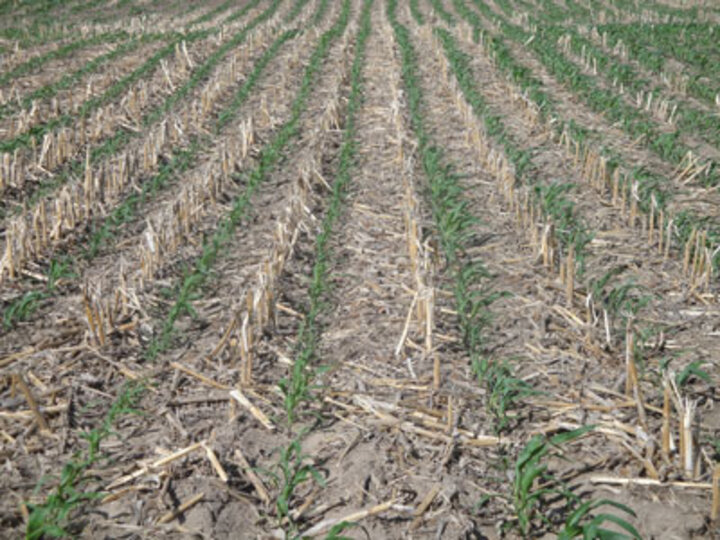April 5, 2013
Residue and growing vegetation protect the soil surface from erosion by absorbing the energy of raindrop impact and reducing soil particle detachment. Reducing the impact also reduces surface crusting and sealing, enhances infiltration, and decreases runoff.

By creating small dams and obstructions along the flow path, residue
- slows the velocity of the runoff,
- reduces the amount of soil transported, and
- reduces the amount of additional soil particles detached by the flowing water.
When flow velocity is reduced, more time is allowed for infiltration and some soil particles already in the runoff water are deposited.
Throughout the year, residue protects the soil from the sun and wind, reducing losses through evaporation. In winter it traps moisture through winter snowfall. Crop residue also reduces evaporation from the soil (see How Tillage and Crop Residue Affect Irrigation Requirements) and keeps the soil surface cooler. It reflects some sunlight energy back to the air and acts as insulation to keep the soil cooler in the heat of the summer. This cooler, moist surface allows better root development during the growing season, improving the standability of corn.
No-till Saves Water and Improves Infiltration
Using no-till can save far more than fuel, labor, and equipment costs. The savings in soil moisture can be just as important, especially in a year when soil moisture and precipitation are short or when irrigation is costly or water supplies are limited. With continuous no-till, the improved soil structure and residue cover will enhance productivity and profitability even more.
Too often soils dry to the depth of tillage. An average silt loam soil holds about 2 inches of plant-available soil moisture per foot of soil. Tilling the soil can result in a loss of 1/2 to 3/4 inch of soil moisture with each trip. With multiple tillage trips, there may not be adequate soil moisture in the seed zone for uniform germination and emergence even though there may be sufficient moisture the rest of the year.
Greater yet are the soil moisture losses from evaporation once tillage destroys residue cover. Tillage also breaks up soil structure and pulverizes the soil surface, creating a condition that seals the soil, resulting in more runoff and less effective rainfall or irrigation. UNL research with a rainfall simulator at Sidney demonstrated that effect in a wheat-fallow rotation. More than 3.75 inches of water was applied in 90 minutes on continuous no-till before runoff started, compared to only 1.0 inch of water applied in 20 minutes on plowed ground.
Infiltration
| Tillage system |
Soil permeability (in/hr) |
Rainfall rate to create runoff (in/hr) |
| Disk & Plant | 0.4 | 1.5 |
| Ridge-plant | 1.5 | 3.2 |
| Slot-plant | 4.0 | 6.4 |
With the improved soil structure of continuous no-till, infiltration also improves, reducing runoff even more. Research at the UNL Rogers Memorial Farm near Lincoln showed a much greater infiltration rate for no-till, over 4 inches per hour, than for tilled conditions, only 0.4 inches per hour, after 25 years of continuous tillage system evaluation. Similar results were measured at the UNL South Central Ag Lab near Clay Center after 30 years of continuous tillage system evaluation (Table 1). With better infiltration, storms of greater intensity will have less runoff and can provide more water in the soil profile for use later in the season.
Reducing Evaporation Losses
Contrary to the belief that residue will eliminate evaporation, it still takes place from the soil, the residue itself, and from the crop canopy every time they get wet. This loss has been estimated to be around 0.08 to 0.1 inch each time. This is why light, frequent rains or irrigations are less effective than longer, soaking ones. Many center-pivot irrigators have problems with runoff on sloping, tilled soils so they apply small amounts, quite frequently, typically only 1/2 inch at a time. One-tenth of an inch evaporation out of 1/2 inch applied is a 20 percent loss, even more if runoff occurs. When adopting continuous no-till under center pivot irrigation, the pivot can apply a greater amount of water before runoff occurs (Table 1). With more water applied, less often, the evaporation and runoff losses are reduced and irrigations can be scheduled to make better use of naturally occurring rainfall.
Summary
By adopting continuous no-till and using residue management, more water is available for crop production. If producers don’t change their cropping practices to make use of that water, they may complain that no-till soils are too cold and wet. Or if their soils cannot store all the water is when it is available, deep percolation may occur, potentially leaching nutrients out of the root zone. Examples of changes to use the “extra” water include: increasing seeding and fertilizer rates for higher yields; implementing more intense and diverse crop rotations; using cover crops, relay cropping, or double cropping; and, for irrigators, applying less irrigation water.
Paul Jasa
Extension Engineer
